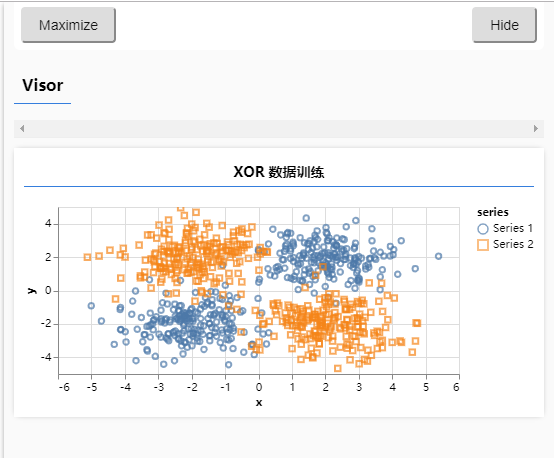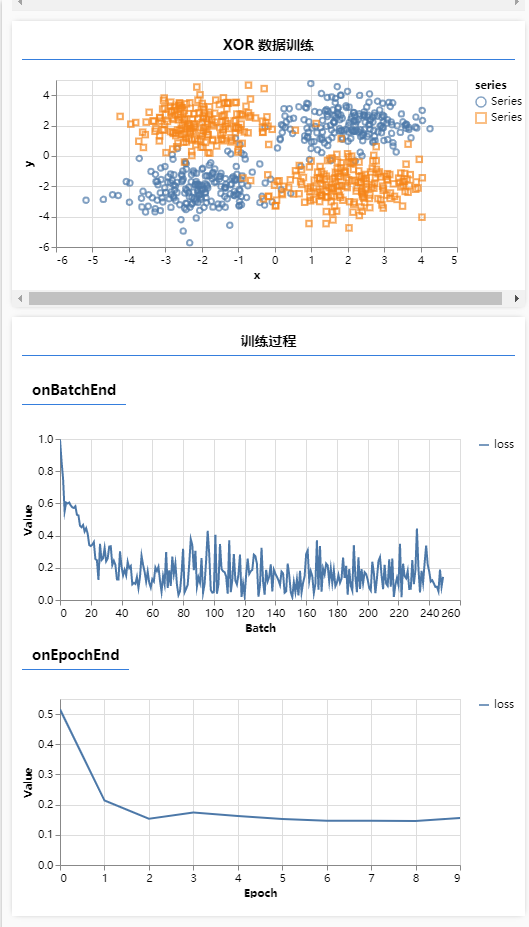# 多层神经网络任务
# 加载 XOR 数据集
data.js
export function getData(numSamples) {
let points = [];
function genGauss(cx, cy, label) {
for (let i = 0; i < numSamples / 2; i++) {
let x = normalRandom(cx);
let y = normalRandom(cy);
points.push({ x, y, label });
}
}
genGauss(2, 2, 0);
genGauss(-2, -2, 0);
genGauss(-2, 2, 1);
genGauss(2, -2, 1);
return points;
}
/**
* Samples from a normal distribution. Uses the seedrandom library as the
* random generator.
*
* @param mean The mean. Default is 0.
* @param variance The variance. Default is 1.
*/
function normalRandom(mean = 0, variance = 1) {
let v1, v2, s;
do {
v1 = 2 * Math.random() - 1;
v2 = 2 * Math.random() - 1;
s = v1 * v1 + v2 * v2;
} while (s > 1);
let result = Math.sqrt((-2 * Math.log(s)) / s) * v1;
return mean + Math.sqrt(variance) * result;
}
1
2
3
4
5
6
7
8
9
10
11
12
13
14
15
16
17
18
19
20
21
22
23
24
25
26
27
28
29
30
31
32
33
34
35
36
2
3
4
5
6
7
8
9
10
11
12
13
14
15
16
17
18
19
20
21
22
23
24
25
26
27
28
29
30
31
32
33
34
35
36
import * as tfvis from "@tensorflow/tfjs-vis";
import { getData } from "./data";
window.onload = () => {
const data = getData(400);
tfvis.render.scatterplot(
{ name: "XOR 数据训练" },
{
values: [data.filter(p => p.label === 0), data.filter(p => p.label === 1)]
}
);
};
1
2
3
4
5
6
7
8
9
10
11
12
2
3
4
5
6
7
8
9
10
11
12

# 定义模型结构:多层神经网络
import * as tf from "@tensorflow/tfjs";
import * as tfvis from "@tensorflow/tfjs-vis";
import { getData } from "./data";
import { mod } from "@tensorflow/tfjs";
window.onload = () => {
const data = getData(400);
tfvis.render.scatterplot(
{ name: "XOR 数据训练" },
{
values: [data.filter(p => p.label === 0), data.filter(p => p.label === 1)]
}
);
const model = tf.sequential();
// 添加隐藏层 加入4个神经元比较稳定,
model.add(
tf.layers.dense({
units: 4,
inputShape: [2],
activation: "relu"
})
);
// 添加输出层 dense上一个的输出是下一个的输入,所以不用在写inputShape
model.add(
tf.layers.dense({
units: 1,
activation: "sigmoid"
})
);
};
1
2
3
4
5
6
7
8
9
10
11
12
13
14
15
16
17
18
19
20
21
22
23
24
25
26
27
28
29
30
31
2
3
4
5
6
7
8
9
10
11
12
13
14
15
16
17
18
19
20
21
22
23
24
25
26
27
28
29
30
31
# 训练模型并预测
import * as tf from "@tensorflow/tfjs";
import * as tfvis from "@tensorflow/tfjs-vis";
import { getData } from "./data";
window.onload = async () => {
const data = getData(400);
tfvis.render.scatterplot(
{ name: "XOR 数据训练" },
{
values: [data.filter(p => p.label === 0), data.filter(p => p.label === 1)]
}
);
const model = tf.sequential();
// 添加隐藏层 加入4个神经元比较稳定,
model.add(
tf.layers.dense({
units: 4,
inputShape: [2],
activation: "relu"
})
);
// 添加输出层 dense上一个的输出是下一个的输入,所以不用在写inputShape
model.add(
tf.layers.dense({
units: 1,
activation: "sigmoid"
})
);
model.compile({
loss: tf.losses.logLoss,
optimizer: tf.train.adam(0.1)
});
const inputs = tf.tensor(data.map(p => [p.x, p.y]));
const labels = tf.tensor(data.map(p => p.label));
await model.fit(inputs, labels, {
epochs: 10,
callbacks: tfvis.show.fitCallbacks({ name: "训练过程" }, ["loss"])
});
window.predict = form => {
const pred = model.predict(
tf.tensor([[form.x.value * 1, form.y.value * 1]])
);
alert(`预测结果: ${pred.dataSync()[0]}`);
};
};
1
2
3
4
5
6
7
8
9
10
11
12
13
14
15
16
17
18
19
20
21
22
23
24
25
26
27
28
29
30
31
32
33
34
35
36
37
38
39
40
41
42
43
44
45
46
47
48
49
50
2
3
4
5
6
7
8
9
10
11
12
13
14
15
16
17
18
19
20
21
22
23
24
25
26
27
28
29
30
31
32
33
34
35
36
37
38
39
40
41
42
43
44
45
46
47
48
49
50
